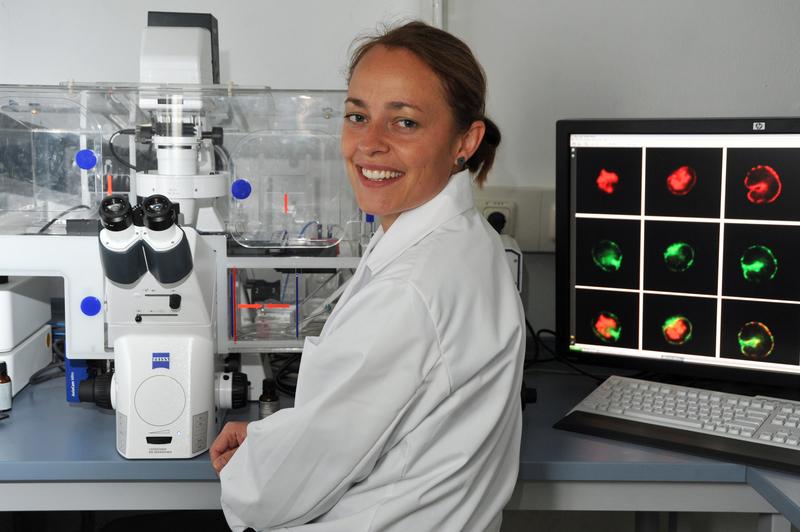

Dr. Ulrike Garscha from Jena University investigates the molecular inflammation processes by fluorescence microscopy.
Photo: Anne Günther/FSU
Asthma bronchiale, hayfever or neurodermatitis – allegies are on the increase in Western European industrial countries. According to the Robert-Koch-Institute every third adult falls ill with an allergy at least once in their lives. The reasons for allergic reactions are inflammation processes of the immune system. The enzyme 5-Lipoxygenase, or in short, 5-LO, plays a pivotal role in this.
“This enzyme regulates the inflammation activities by catalyzing the biosynthesis of pro-inflammatory mediators,“ as Dr. Ulrike Garscha of the Friedrich Schiller University Jena (Germany) says. Therefore, the 5-LO would be a promising target for active compounds in the treatment of inflammatory diseases. However, the pharmacist concedes, there is only one approved pharmaceutical on the US market, and due to serious side-effects it can only be used to a very limited extend.
The Jena junior scientists from the Chair for Pharmaceutical and Medical Chemistry and their small team now have worked out a new approach, which can considerably advance the search for drugs in this area. Ulrike Garscha and her colleagues from Jena together with scientists from the Karolinska Institute in Stockholm published their account of their research in the well-known science magazine 'FASEB Journal'.
In this they report on how they were able to study in detail the mechanism through which the 5-LO together with another protein called FLAP starts the inflammation processes (DOI: 10.1096/fj.15-278010).
To be able to do so, the researchers have developed a cellular system on which they worked for years and which allows them to watch the unfolding processes time-resolved and in high precision. Thus the researchers provide a method through which tests for appropriate candidates for active compounds can be much more finely targeted.
“For some years there has been the assumption that 5-LO and FLAP interact,“ stresses Prof. Dr. Oliver Werz from the University Jena, at whose chair Dr. Garscha's team works. As soon as a cell of the immune system receives an inflammation signal, the 5-LO, which normally moves freely within the cell, wanders to the membrane of the cell nucleus and interacts there with FLAP. “Only when they are associated with each other the two molecules are able to unfold their impact and to start an inflammation,“ says Werz.
Although this assembly has been widely acknowledged by the international scientific community it has until now never been established conclusively: The Jena pharmacists were the first to prove it. To this end they made the interaction of the partaking proteins in human immune cells visible through fluorescent dye and observed the result by microscopy. Thus the scientists were also able to clarify the exact regulatory mechanism through which the two molecules control the inflammatory process.
“While to start with in the first minutes of the interaction a flexible complex from both molecules is formed, which induces the synthesis of pro-inflammatory substances, after two to three minutes a stable assembly of 5-LO and FLAP is formed, which decreases the activity of the enzymes again,“ Ulrike Garscha explains. The 36 year old junior scientist is convinced that new therapeutic approaches in the treatment of inflammatory diseases will derive from these findings in the long run.
Original Publication:
Gerstmeier J et al. Time-resolved in situ assembly of leukotriene-synthetic 5-lipoxygenase/5-lipoxygenase-activating protein complex in blood leukocytes, The FASEB Journal 2015, DOI: 10.1096/fj.15-278010
Contact:
Dr. Ulrike Garscha, Prof. Dr. Oliver Werz
Institute of Pharmacy
Friedrich Schiller University Jena
Germany
Philosophenweg 14, 07743 Jena
Phone: ++49 3641 / 949811, ++49 3641 / 949801
Email: ulrike.garscha[at]uni-jena.de, oliver.werz[at]uni-jena.de












